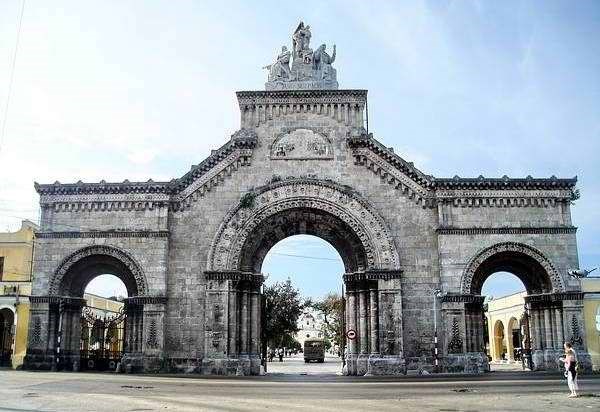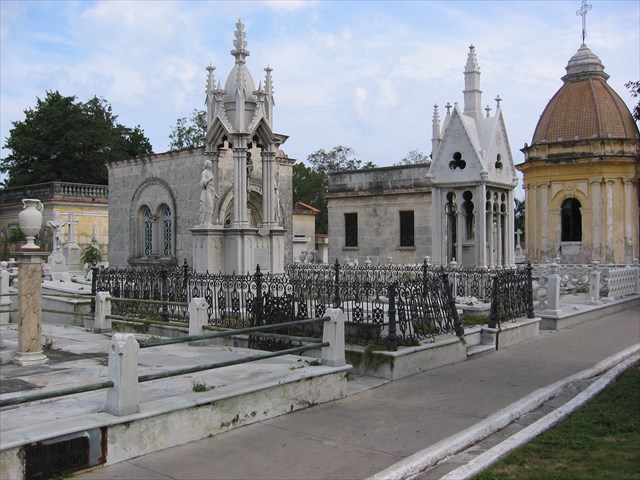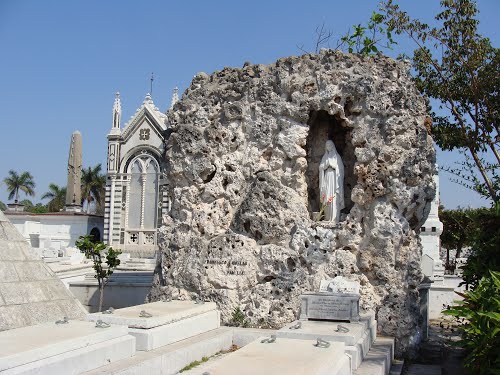Necropolis EarthCache
-
Difficulty:
-

-
Terrain:
-

Size:  (other)
(other)
Please note Use of geocaching.com services is subject to the terms and conditions
in our disclaimer.
En la ciudad de La Habana, que vale la pena visitar la Necrópolis de Cristóbal Colón, que abre todos los días 08 a.m.-5 p.m. (Tenga en cuenta que para los no residentes, se requiere un cargo de 5 CUC/persona para entrar.) Este cementerio fue nombrado en honor al explorador genovés famoso descubridor de Cuba en 1492. Este cementerio refleja el envejecimiento de la sociedad cubana en general - los rastros de un esplendor de antaño presentando estoicamente un frente real en medio de la decadencia y el abandono a su alrededor. Un paseo por el cementerio tendrá que mirar a los templos en miniatura greco- romanas , pirámides egipcias, castillos medievales, etc. Al igual que las otras tumbas, esta Caché Tierra es una gran estructura . Sin embargo , a diferencia de las otras tumbas de mármol o granito liso, esta tumba está construida con piedra caliza cruda tomada de una costa cercana.

Vista de la entrada principal al cementerio

Un paseo por el cementerio revela tumbas elaboradas

Vista de la tumba
CALIZA
La piedra caliza es una roca sedimentaria compuesta principalmente de calcita y aragonita la minerales, que son diferentes formas de cristales de carbonato de calcio(CaCO3). La mayoría de piedra caliza se compone de fragmentos de esqueletos de organismos marinos, como los corales o los foraminíferos. Calizas son generalmente tonos de gris azulado para broncearse, aunque existen otros colores. Brown y tonos amarillos son causados generalmente por las impurezas de óxido de hierro y de color gris oscuro a negro colores son causados por material orgánico. Calizas de varios tipos cubren cerca de dos terceras partes de la isla.
TECTÓNICA DE PLACAS EN EL TRABAJO
Geológicamente, al menos, Cuba es parte de América del Norte; el límite entre las placas de Norteamérica y el Caribe va de este a oeste por debajo del Mar Caribe al sur de la isla. A lo largo del margen de la placa es un profundo valle de la grieta bajo el agua, que cubre el trayecto entre Cuba y Jamaica. Esta característica es muy cerca de la costa de Cuba, al sur de la Sierra Maestra, con agua de caer a 6000 m sólo unos pocos kilómetros de la costa. Los movimientos de la Tierra a lo largo del límite de placas hacen que la región oriental de Cuba, la parte más propensa a los terremotos del país.
Movimientos de las placas actuales están empujando a Cuba hacia el oeste y la placa del Caribe al este. Cuba también se inclina gradualmente hacia el norte. La costa norte, donde se encuentra La Habana, se está convirtiendo poco a poco desde el mar. Los arrecifes de coral viejos han sido llevados a la superficie , y ahora forman gran parte de la costa, por lo que gran parte de la costa norte se compone de acantilados de piedra caliza de coral y playas de arena. Un corto camino hacia el interior, viejas líneas de acantilados que marcan las etapas de la aparición de la costa forman una serie de terrazas de coral, uno de los cuales se ejecuta justo al noreste del Hotel Nacional de La Habana. Es a partir de estas zonas de piedra caliza, que las rocas utilizadas en la construcción de la tumba que ves frente a ti se originaron.
VEDADO FORMACIÓN
La formación particular de la piedra caliza de la que se construyó la tumba es parte de la formación del Vedado. Esta formación va como un cinturón estrecho y no continua sobre la costa norte de La Habana, Ciudad de la Habana y las provincias de Matanzas, y en la costa sur de Pinar del Río, Matanzas y Cienfuegos (en las provincias centrales al sur). La formación Vedado probablemente se formó en el Plioceno superior (hace 5,33-2,58 millones de años) al Pleistoceno inferior (hace 2,58 millones a 11.700 años) épocas.
Para registrar esta Caché Tierra, por favor envíeme un correo electrónico las respuestas a las siguientes preguntas. Por favor, te enviaremos un correo electrónico las respuestas al mismo tiempo que inicia la sesión el caché. Se eliminarán los registros sin respuestas.
1. Examinar las rocas que forman la estructura de la pared. Describir algunas de las criaturas que ves incrustado dentro de las rocas.
2. Describir los colores de las rocas que se ven y la hipótesis de las razones de los distintos colores visibles.
3. Sobre la base de lo que has aprendido, cien años a partir de ahora, ¿cree que la elevación está de pie será más alto, más bajo, o el mismo como lo es hoy?
RECURSOS
http://en.wikipedia.org/wiki/Limestone http://www.footprinttravelguides.com/latin-america/cuba/about-cuba/land-and-environment/geology-and-landscape/
http://www.earthmagazine.org/article/travels-geology-journeying-through-cubas-geology-and-culture
http://en.wikipedia.org/wiki/Pliocene
http://en.wikipedia.org/wiki/Pleistocene
Management of Water Resources in Protected Areas Farfán González, H., Corvea Porras, J.L., de Bustamente Gutiérrez, I., LaMoreaux, J.W. (Eds.) 2013, XVII, 363 p. 87 illus., 76 illus. in color.
In the city of Havana, it's worth visiting the Necropolis de Cristobal Colón (Christopher Columbus) which is open daily from 8 am to 5 pm. (Please be aware that for non-locals, a charge of 5 CUC/person is required to enter.) This cemetery was named after the famed Genoese explorer who discovered Cuba in 1492. This aging cemetery reflects the Cuban society at large – traces of a bygone splendor stoically presenting a regal front amid the decay and disrepair around it. A stroll around the cemetery will have you looking at miniature Greco-Roman temples, Egyptian pyramids, Medieval castles etc. Much like the other tombs, this Earthcache is a large structure. However, unlike the other tombs made of smooth marble or granite, this tomb is constructed with raw limestone taken from a nearby coastline.

View of the main gates to the cemetery

A stroll through the cemetery reveals elaborate tombs

View of the tomb
LIMESTONE
Limestone is a sedimentary rock composed largely of the minerals calcite and aragonite, which are different crystal forms of calcium carbonate (CaCO3). Most limestone is composed of skeletal fragments of marine organisms such as coral or foraminifera. Limestones are usually shades of bluish gray to tan, although other colors do exist. Brown and yellow shades are usually caused by iron oxide impurities and dark-gray to black colors are caused by organic material. Limestones of various types cover about two-thirds of the island.
PLATE TECTONICS AT WORK
Geologically at least, Cuba is part of North America; the boundary between the North American and Caribbean plates runs east-west under the Caribbean Sea to the south of the island. Along the plate margin is a deep underwater rift valley, which runs between Cuba and Jamaica. This feature is quite close to the Cuban coast to the south of the Sierra Maestra, with water plunging to 6000 m only a few miles offshore. Earth movements along the plate boundary make the eastern region of Cuba the most earthquake-prone part of the country.
Current plate movements are pushing Cuba to the west and the Caribbean plate to the east. Cuba is also being tilted gradually to the north. The northern coastline, where Havana is located, is gradually emerging from the sea. Old coral reefs have been brought to the surface, and now form much of the coastline, so that much of the northern coast consists of coral limestone cliffs and sandy beaches. A short way inland, old cliff lines marking stages of coastal emergence form a series of coral terraces, one of which runs just northeast of the Hotel Nacional in Havana. It is from these limestone areas, that the rocks used in constructing the tomb you see in front of you originated.
VEDADO FORMATION
The particular formation of limestone from which the tomb was constructed is part of the Vedado formation. This formation goes as a narrow and non-continuous belt about the north shore of La Habana, Ciudad de la Habana and Matanzas provinces, and at the south coast of Pinar del Rio, Matanzas and Cienfuegos (in the south central provinces). The Vedado formation likely formed in the upper Pliocene (5.33 to 2.58 millions years ago) to Lower Pleistocene (2.58 million to 11,700 years ago) epochs.
To log this earthcache, please email me the answers to the following questions. Please email you answers at the same time as you log the cache. Logs without answers will be deleted.
1. Examine the rocks making up the wall structure. Describe some of the creatures that you see embedded within the rocks.
2. Describe the colors of the rocks that you see and hypothesize the reasons for the various colors visible.
3. Based on what you’ve learned, one hundred years from now, do you think the elevation you are standing will be higher, lower, or the same as it is today?
RESOURCES
http://en.wikipedia.org/wiki/Limestone http://www.footprinttravelguides.com/latin-america/cuba/about-cuba/land-and-environment/geology-and-landscape/
http://www.earthmagazine.org/article/travels-geology-journeying-through-cubas-geology-and-culture
http://en.wikipedia.org/wiki/Pliocene
http://en.wikipedia.org/wiki/Pleistocene
Management of Water Resources in Protected Areas Farfán González, H., Corvea Porras, J.L., de Bustamente Gutiérrez, I., LaMoreaux, J.W. (Eds.) 2013, XVII, 363 p. 87 illus., 76 illus. in color.
Additional Hints
(Decrypt)
Pbzb ynf havqnqrf qr TCF ab rfgáa crezvgvqbf ra Phon, fvtn rfgnf frapvyynf vafgehppvbarf cnen rapbagene ry pnpué. Qrfchéf qr ragene ra ry przragrevb n geniéf qr ynf tenaqrf chregnf cevapvcnyrf, pnzvane cbe ry pnzvab cevapvcny unfgn dhr unln han mban erqbaqrnqn (4 cnyznf n yn vmdhvreqn l 4 n yn qrerpun). Tver n yn qrerpun ra ry pnzvab nyyí l yhrtb gbzne ry fvthvragr n yn vmdhvreqn . Yn ghzon qr Senapvfpb Ynzrynf qroreín fre zhl boivb cnen hfgrq ra fh ynqb vmdhvreqb n zrqvqn dhr pbagvaúr pnzvanaqb han qvfgnapvn zhl pbegn.
Nf TCF havgf ner abg nyybjrq va Phon, sbyybj gurfr fvzcyr qverpgvbaf gb svaq gur pnpur. Nsgre ragrevat gur przrgrel guebhtu gur ynetr znva tngrf, jnyx qbja gur znva cngu hagvy gurer vf n ebhaqrq nern (4 cnyzf gb gur yrsg naq 4 gb gur evtug). Gnxr n evtug ng gur ebnq gurer naq gura gnxr gur irel arkg yrsg. Gur gbzo bs Senapvfpb Ynzrynf fubhyq or irel boivbhf gb lbh ba lbhe yrsg unaq fvqr nf lbh pbagvahr jnyxvat n irel fubeg qvfgnapr.